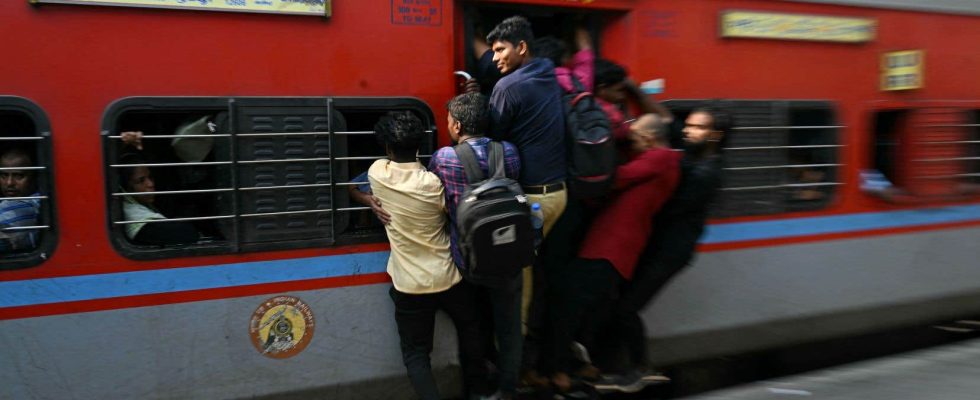According to polls, the coalition of Indian opposition parties does not appear to have convinced the electorate to abandon the current Prime Minister, Narendra Modi. However, this grouping, called NDIA, brings together an impressive number of 40 political parties – from communists to the far right, including Muslim parties and other political-religious groupings.
The only commonality: a desire to dethrone the right-wing Hindu nationalist Bharatiya Janata Party (BJP) and its leader.
During this electoral marathon which will last more than a month (from today, April 19, until April 1er next June), it is more logistics than political allegiances that are putting obstacles in the way of the alliance of opposition parties. Organizing single-candidate races to win MPs from different parties in India’s 543 constituencies is easier said than done. It is the largest electorate in the world, with 969 million people going to the polls, exceeding the entire population of the European Union.
One poll calculates that the BJP and Modi could win up to three-quarters of the seats in the Lok Sabha (the “people’s house”, similar to the National Assembly). Its objective is to obtain 400 seats out of 543 in order to further establish its hold on the electorate of the most populous country in the world.
And although there are more than 2,500 political parties in India, it is a superficial pluralism, since only 10 parties hold 86% of the seats in the Lok Sabha. Even the Indian National Congress party, the country’s oldest political party, has failed to establish effective leadership in organizing the opposition. The party of Jawaharlal Nehru, then of his daughter Indira Gandhi, ruled the country for more than two-thirds of the years after the country’s independence in 1947.
The support figures for the BJP come in particular from the fact that it muzzles its opponents through various legal tactics that Amnesty International describes as “political repression against the opposition”.
Thus, the chief minister of Delhi, Arvind Kejriwal, a notorious critic of the government, was arrested for money laundering in mid-March, and the Indian National Congress party accuses the government of having frozen his bank accounts under the The aegis of a tax dispute dating from 2018. Interestingly: some legal proceedings against opposition parties were dropped when they joined the BJP coalition.
Modi’s legacy
Presenting himself as a man of the people and the son of a tea seller from Gujarat, Narendra Modi announced during his first election as prime minister, in 2014, that “good times are coming” (“good times are coming”). good times are coming “). Has the prophecy come true?
On the one hand, the economy has almost doubled since 2014 and the value of the Indian stock market has tripled, feats appreciated by international banks like Morgan Stanley and JPMorgan Chase. The sale of luxury goods, such as high-end cars, has also increased, even creating waiting lists in certain sectors. India recently reportedly became the world’s fifth largest economy, overtaking the United Kingdom, and it could overtake Japan and Germany in the coming years to become third, behind the United States and China.
On the other hand, unemployment reaches 50% among 20 to 24 year olds, and economic inequalities have increased since 2014. While Narendra Modi has extended several social benefits and offered donations of basic foodstuffs and technological objects to poorest sections of the population, India still has the highest poverty rate in the region — around 12% of its population, according to official data. Example of the still low human development index in the country: out of 1000 babies born in 2022, 30 died before their fifth birthday.
In addition, the quality of Indian democracy lost around twenty ranks in the world rankings between 2016 and 2020, while the rating of countries in the same region, such as Nepal or Bhutan, increased. Although it is an exaggeration to say that Indian rule has become authoritarian, some experts say the country is drifting towards an “electoral autocracy” or a hybrid “competitive-authoritarian” system.
One of the most criticized aspects of Narendra Modi’s two terms in power is having allowed to increase – or even encouraged – anti-Muslim and anti-Christian sentiments in this predominantly Hindu country. Last January, the BJP went ahead with the construction of a temple honoring the Hindu god-king Rāma on the site of a 16th century mosque.e century having been destroyed by a Hindu mob in 1992. This added fuel to the still hot embers of the desires between Hindus and Muslims, especially in the province of Gujarat, which Modi led from 2001 to 2014.
Nationalist and pro-Hindu rhetoric is of course very popular with the BJP electorate, as are promises such as changing the name of the country to favor the Sanskrit version, Bhārat, used by Hindi speakers. . Although speaking Hindi does not mean being Hindu, these tactics of Hinduizing the country satisfy the majority of Indian voters, around 43% of whom have Hindi as their mother tongue.
Yet although India is almost 80% people who identify with the Hindu religion, the country has the largest populations of Sikhs and Jains, the third largest Muslim population, and the fourth largest Buddhist population in the world. Because India is so populous that even minorities represent huge numbers of people.
A third mandate for the BJP could allow it to further establish its ideology of Hindutva (Hinduity), or the strengthening of a Hindu nation-state.
